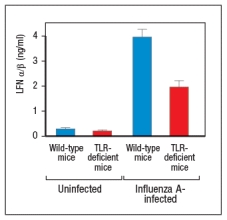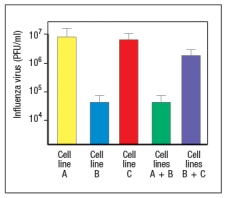Essay
Influenza virus infects and replicates in airway epithelial cells. This virus has a segmented single-stranded RNA genome. Experiments to determine which innate immune sensors were recognizing the virus and inducing production of type I IFNs (IFN- and IFN- ) were performed. For these studies, mice were infected with Influenza A virus by the intranasal route, which leads to a potent infection in the lungs. Two days post-infection, Type I IFNs were measured in the lung; A shows the results. 
a) Name two innate sensor categories that are likely involved in recognizing influenza virus.
b) A common symptom of virus infections is fever. Which innate receptor sensing pathway is most likely responsible for this response, and how is it induced?
Several cell culture lines of epithelial cells, called "Cell Line A, B, or C," are incubated with 104 infectious particles of influenza virus, and viral titers in the culture media are measured 2 days later. Looking at the results of this experiment, it is apparent that the three lines do not all show the same response to the virus. To investigate these differences, mixing experiments are performed, where cells from two different cell lines are mixed together at a 1:1 ratio before the Influenza infection.
c) Based on the results shown in Figure , propose an explanation for these data. 
Correct Answer:

Verified
a) TLRs and Rig-I-like receptors (RLRs)....View Answer
Unlock this answer now
Get Access to more Verified Answers free of charge
Correct Answer:
Verified
View Answer
Unlock this answer now
Get Access to more Verified Answers free of charge
Q1: Cytokine receptors of the hematopoietin superfamily engage
Q2: Macrophages express multiple types of receptors on
Q3: Many different NOD-like receptors, including several with
Q4: Each family of NK cell receptors has
Q5: As a family, TLRs can recognize PAMPs
Q7: Innate lymphoid cells (ILCs) are effector
Q8: Mycobacteria are intracellular pathogens that have adapted
Q9: Many of the inflammatory mediators produced by
Q10: Septic shock is a serious, often fatal
Q11: RIG-I like receptors (RLRs) such as RIG-I,